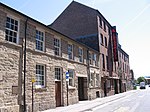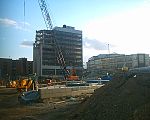All Saints Catholic High School, Sheffield
1976 establishments in EnglandAcademies in SheffieldAll pages needing cleanupAll pages needing factual verificationCatholic secondary schools in the Diocese of Hallam ... and 3 more
Educational institutions established in 1976Secondary schools in SheffieldUse British English from February 2019
All Saints Catholic High School is a Roman Catholic secondary school with academy status in Sheffield, South Yorkshire, England.
Excerpt from the Wikipedia article All Saints Catholic High School, Sheffield (License: CC BY-SA 3.0, Authors).All Saints Catholic High School, Sheffield
Granville Road, Sheffield Park Hill
Geographical coordinates (GPS) Address Website External links Nearby Places Show on map
Geographical coordinates (GPS)
| Latitude | Longitude |
|---|---|
| N 53.37324 ° | E -1.45712 ° |
Address
All Saints' Catholic High School
Granville Road
S2 2RJ Sheffield, Park Hill
England, United Kingdom
Open on Google Maps











